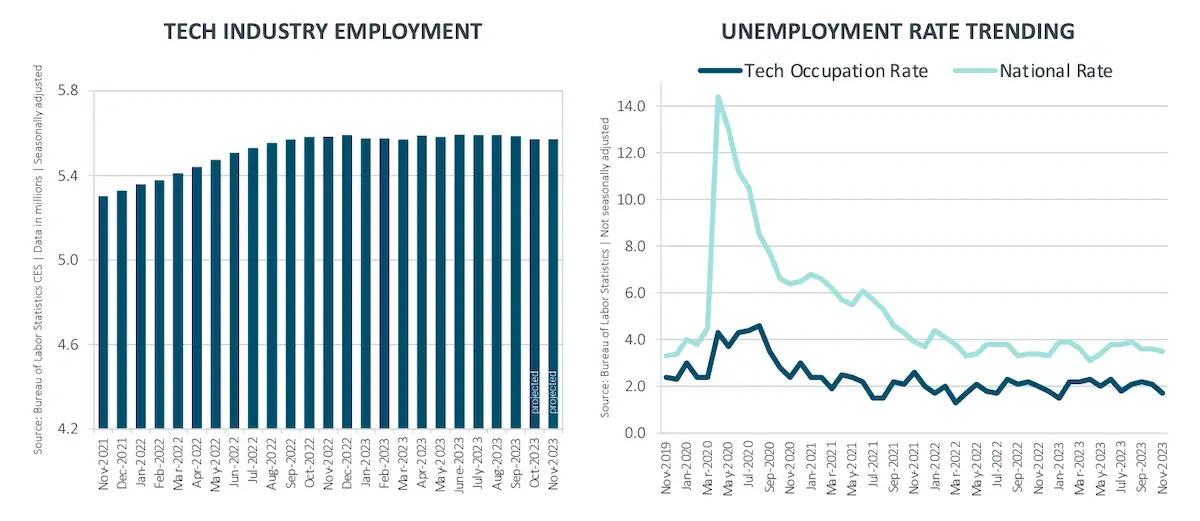Whether you’re just starting to plot your career or planning your next move, it helps to take a look at the future. You’re not alone. In the past three years, 22% of U.S. workers have considered changing careers.
So which jobs of the future should you look at if you want to take your career path in a different direction?
We won’t be taking out our crystal ball to do this—instead, we’ll focus on the various studies into forecasting the state of jobs in the coming decade. These studies have been carried out by the likes of Gartner, Forbes, the Bureau of Labor Statistics, McKinsey, and the World Economic Forum.
Every industry needs tech talent, so which are the jobs of the future? And what disciplines do you need to get there? Let’s jump in!
If you’d like to skip ahead to our list or to a particular section, just use the clickable menu:
- Is tech still a future-proof career?
- The jobs of the future are not just for the young
- Four great technology jobs of the future
- Jobs of the future will be remote
- How to put yourself in the right position for one of these future jobs today
- Final thoughts
1. Is tech still a future-proof career?
Predicting what will become huge and what won’t can be a difficult business. One of the most important factors you need to bear in mind when planning these is to put things in perspective.
What’s the timeframe for your career plans? Is it to be recession-proof or get through a slump? Learning to spot the difference between a trend and an indicator isn’t easy. For example, right now, Meta (formerly Facebook)’s huge investment in the metaverse looks like a failed gamble, but it’s still hard to know in the long run.
Conversely, some things come from nowhere and shake things up entirely. A few months ago, few of us had heard of Chat-GPT, now suddenly, the marketing, academia, and media industries are watching the wild popularity of integrated AI chatbots with alarm.
With that in mind, it’s worth examining whether the series of layoffs among the so-called “Big Tech” companies at the turn of the year is part of a larger trend for tech jobs. Once we’ve looked at that in more detail, we’ll ask what it actually means to “work in tech” in 2024.
Tech jobs in 2024: A perspective
The winter of 2022/23 brought a lot of worry as many tech companies decided to lay off many employees, accelerating in the first half of 2023.
While it’s too early to say how this will play out over the rest of the year, a glance at the top names on layoffs.fyi features some eye-catching ones: Google, Amazon, Meta, and Microsoft. The reasons given for this were uncertain economic winds ahead, but also several admitted overhiring during the Covid-19 pandemic.
However, some perspective is necessary here: First of all, these layoffs are a tiny proportion of the companies themselves. Analysis by The New York Times estimates that the layoffs amount to just 1.2% of Amazon’s workforce, 4.5% of Microsoft’s workforce, and 12.6% of Meta’s. The website estimates that last year 258,803 tech workers were laid off from over 1,100 companies, which is almost 100,000 more than in 2022.
Another thing to examine is who is getting laid off from the “Big Tech” companies—on the whole these are typically more support staff and similar roles instead of tech jobs such as software engineers and analysts. In their February 2023 Jobs Report, CompTIA noted that the tech unemployment rate was 1.5%, compared to the overall U.S. average of 3.4%. Looking at the figures, they observed:
“The tech unemployment rate is also an indication that many of the layoffs occurring at the tech sector level are non-technical workers, such as sales, marketing, or related business support positions.”
Outside of the “Big Tech” companies, tech in the U.S. is still thriving: in January 2023, it entered its 26th straight month of growth, which only slowed slightly throughout the year, as you can see.

It’s also worth bearing in mind the amount of tech job opportunities: The World Economic Forum’s Future of Jobs Report estimated that 97 million new roles may be created by technological development globally by 2025. This is not just what we would consider the tech industry—the report is across 15 different industries, from manufacturing to healthcare, from energy to the auto industry.
As you can see, the vast majority of those 97 million roles are not jobs in tech companies, but tech jobs. Let’s examine the important difference between the two.
Tech jobs vs jobs in tech
It sounds obvious, but: not every tech job is a job in the tech industry. In fact, almost the opposite is true, and this is only set to continue between now and 2030.
Since the recent “Big Tech” layoffs, a lot more attention is turned to the demand for tech workers in non-tech industries. In fact, firms as varied as the insurance industry and the Dept of V.A. Affairs have openly been courting tech workers. Banking giant JP Morgan is hiring over 2,000 engineers after recruiting over 5,000 developers and data scientists in 2021.
With that in mind, it’s good to look at broader economic statistics for signs of opportunities in tech jobs: In the last quarter of 2022, while tech companies struggled with higher interest rates, the US economy was growing by 2.9%.
The digital transition is taking off across all sectors, and as it does, it’ll create many opportunities. The Future of Jobs Report also highlights that 34% of businesses stated that they were going to grow their workforce due to technology integration.
Overall, the rising interest rates that have made it harder to raise capital lately are forcing businesses across all sectors to focus on profitability, not growth. Instead of inhibiting it, this is actually encouraging the digital transition, as companies have to work smarter.
According to the World Economic Forum, the top three industries of strategic importance for technological development may surprise you: agriculture, education, and energy. This, too, is only good news for career-changers, as previous experience and familiarity with these sectors combined with tech skills will make them highly employable candidates.

2. The jobs of the future are not just for the young
So, where will the workers to fill these tech jobs of the future come from? Well, these will be made up in part of professionals already working, but they won’t nearly be enough.
This leaves a huge amount of opportunities for those who have changed careers to tech. These reskillers and upskillers might even come from the same industry—or even company. A study of global executives showed that 82% expect to address more than half of their tech skills gaps through re- and upskilling.
It follows, then, that these will come from all corners of the workforce, no matter what age they are. Don’t expect college leavers and high-school graduates to be able to fill these technology jobs of the future—the need is far more acute than that. The tech skills gap is real.
So, now that we’ve seen that technology jobs will become a part of almost every industry and won’t be entirely carried out by those straight out of high school, let’s go through some examples.
3. Four great technology jobs of the future: 2025 and beyond
Without further ado, here are four fascinating tech jobs of the future. Don’t forget that while the job title might not be exact, it’s more about the area itself.
These should serve as a jumping-off point for your research. Try and learn more about the role by the field around it, the skills you’ll be expected to know in the job, and how to pick up these skills.
Big data engineer
You’ve probably already heard of this role, as big data is already a huge part of our society—this trend is firmly set to continue. As the number of firms and industries taking advantage of access to large amounts of information increases, so too do the job opportunities.
The 2020 Tech Job Report by Dice found big data engineer to be the fastest-growing tech job. While the 50% year-on-year growth rate won’t be sustained at such a high rate, big data engineer salaries are already firmly in the six figures.
What do big data engineer jobs of the future look like? Well, just like with software engineering, the role will start changing based on the variety of industries they are working in and evolve into subfields.
If you’re wondering how to begin your own journey to this role, check out our guide to how to become a big data engineer.
Content marketing creator/marketing analyst
Marketing has come a long way from simply creating content and advertising campaigns. In this highly technologized world, the case is often to adapt or fail.
In 2022 the content creation market reached 13.4 billion and is projected to reach $47.2 billion by 2032. This is not just about the content creators themselves, but all of the related roles from this, including content strategists. Their job will not just be to track and analyze trends but also which platforms consumers are using and which are up-and-coming.
Another cornerstone of marketing in the next decade will be marketing analysts. These professionals use empirical data and research to help support and plan further campaigns, as well as deliver insights into current and past ones.
While they typically work in-house, expect to see far more freelance marketing analysts offering their services to clients, enabling small and medium businesses to maximize their marketing impact.
A combination of the possibilities that AI brings, allied with the growing number of marketing channels, are two big reasons that marketing analysts are going to be even more in demand in the next decade. With the US Bureau of Labor Statistics predicting a whopping 19% growth from 2021-2031, this definitely is a job of the future to watch.
If you’d like to get an idea of which areas are up-and-coming in the field, check out our list of marketing trends for the future.
Data ethics officer
If you’re going to be dealing with large amounts of users’ information, there need to be guardrails. With big data comes big responsibility.
While up until now, this has come mostly under the purview of data analysts and scientists, expect it to become a role or family of roles all of its own. The importance and financial support for data ethics officers or data ethicists is obvious—data breaches or improper use can cost companies millions in fines as well as billions in damage to their reputations.
Fines? That sounds like this should be the job of compliance and legal teams, right? Wrong—in their analysis of the area, McKinsey argue that data ethics teams need to be diverse to be successful.
Career-changers are particularly advantaged here: Being able to combine previous experience in another field with data analysis skills will set you up well for this developing area.
Cloud architect
It’s a revolution that has already been taking place for several years, but the transition to cloud computing is only really getting started. With so many industries migrating or increasing their cloud storage and computing capacities, this is an area of particular focus. Last year, Gartner estimated that around $500 billion was spent worldwide on this area for end users alone.
Almost every type of company can benefit from a product such as Amazon Web Services, so it’s no surprise that there is a huge demand for talent in this field. Gartner estimates that 50% of all cloud IT migration projects are delayed up to two years simply because of the lack of skills.
In the next five years or so, expect trends such as multi-cloud computing to become the industry norm, as well as even more smaller businesses using the cloud to scale up. Naturally, there will be a huge demand for cloud engineers to implement and maintain cloud migrations and for data scientists and analysts to benefit from them, but the key will be the cloud architect.
Cloud architects are those who design and oversee a company’s cloud infrastructure, operating at a high level. With only a limited number of individuals out there right now with the level of experience and skills to carry out this role, competition for them is fierce. It’s no surprise then that according to Glassdoor, average salaries for this role range from $150,000–260,000.

Now that you’ve had a look at how to future-proof your career, it’s worth looking at where the tech jobs of the future will be worked.
4. Jobs of the future will be remote
Although these roles we’ve covered are incredibly broad, it’s no surprise that all of them can be done remotely.
Just like the current fears about tech jobs due to the layoffs in “Big Tech” companies, companies’ attempts to get their employees back into the office are not indicative of the future reality. The benefits of remote work are almost too many to name, but they’ve made a real difference in people’s lives. Having had a taste of this “new normal” in the wake of the pandemic, workers are not prepared to give up their hard-earned freedoms.
The numbers are stark: some studies estimate that the increase in people working from home during Covid-19 was equal to 30 years of pre-pandemic growth. Another sure sign of remote work being the future is the demand for it: back in September 2022, 14% of job ads on Linkedin were remote, but these attracted 52% of the total applications.
One reason jobs in “Big Tech” companies aren’t as attractive as in the past to tech workers is not just the job security offered by other industries, it’s also the conditions. With companies like Apple still trying to force workers to come to the office, perks such as home office or a four-day work week are also a huge draw now offered by smaller companies.
In short, professionals who are able to work from home want more remote work and less in-person work than their employers are offering at present.
If you’d like to learn more about how to position yourself best for this format, check out our dedicated remote work guide.
So let’s say you’ve spotted one of these jobs of the future and think it’s worth exploring some more. Maybe it’s adjacent to your current career or an evolution of it.
Maybe looking at your current skillset, you can see that you have some transferable skills that could be really suitable for it. What do you do next?
5. How to put yourself in the right position for one of these future jobs today
We hope that by now, you’ve gotten a good idea of what’s coming around the corner. Not just in terms of which tech jobs are going to become hot property but also the global shortage of expertise in these positions.
So, how do you make a solid path to achieve these goals? Well, the first step is to start planning your journey. Make sure that your goal is reasonably specific (e.g. “To become an experienced AWS cloud architect” so that you can orient your education around it.
Having been on the scene since 2011, tech skills bootcamps have become a thriving part of the education sector, allowing hundreds of thousands around the world to future-proof their careers. [With CompTIA noting that 30% of job postings in 2023 are for positions in emerging technologies, online schools such as CareerFoundry focus on teaching people these skills.]
Let’s briefly go through the different programs which CareerFoundry offers, all tailored to the jobs of the future:
UX/UI and Product design
Having been popular for several years now, this field is set to continue growing. From $960 million in 2021, the global UX and UI are expected to continue to reach over $3205 million by the year 2027.
The job-focused nature of the CareerFoundry UX and UI design programs have made them firm favorites in the field, with graduates snapped up by companies in every kind of industry— including health, energy, and insurance.
If you want to get a glimpse into what the future holds for this field, our guide to future UX trends will shed some light. New positions are also emerging and growing quickly—just look at the UX researcher and UI developer roles, which have exploded onto the scene.
Given the ever-changing nature of the field and the inability of established education to keep up with the intersection of design and technology, it’s no surprise that becoming a UX designer without a degree is a well-trodden path.
A curriculum focused on real-world design tools such as Figma and Sketch and practical design skills are combined with a flexible learning schedule to help you adapt the course to your own schedule. That way, you can finish the entire UX program in 5–10 months, depending on your own commitments.
Check out more details about the UX Design Program or the UI Design Program, or our brand-new Product Design Program to see which might suit you best.
If you’re interested, talk to one of our advisers about UX design, UI design, or Product Design. They’ll help you work out which one is best for you and your journey.
Data analytics
By now, you’ve already worked out just how in-demand data analytics skills will be to jobs of the future. Pretty much all of the roles we talked about earlier will involve using analytics to draw conclusions from large amounts of data, and the data skills gap is a huge issue for businesses.
Re-skilling or upskilling in the field is so popular now that it’s quite possible to start a career with no previous data experience. Such is the amount of data available out there in every conceivable sector, creating and filling a data analytics portfolio is achievable.
CareerFoundry’s Data Analytics Program is an excellent way to give yourself the education necessary to work towards these roles, whether that’s a marketing analyst or a big data engineer.
You’ll complete the program over 5–8 months, depending on your choice of pace. As you progress, you’ll be accompanied by a tutor and mentor, both seasoned data professionals. These two, allied with your career specialist, will combine to give you an idea of what is expected of data analysts in the field today, as well as how to plan your data career.
If you’re further interested in pursuing data analytics, talk to one of our advisers. They’ll help you plan out your journey.
Product management
Like both data and UX/UI design, the product management field is also filled with career-changers. In fact, a 2022 report by ProductSchool found that over 50% of PMs come from non-product backgrounds.
This is probably the result of two main factors—the lack of formal product manager programs in universities, and the huge amount of demand for the position in today’s product-driven world.
Unsurprisingly, then, learning how to become a product manager is a path many are taking in 2024. The fact that so many product management skills are transferable from other roles means it’s particularly well-suited to those thinking of changing careers. The fact that average salaries in the U.S. are almost double the national average is the cherry on top.
Check out more details about the Product Management Program to see how it might suit you.
If you’re further interested in pursuing a career in product management, talk to one of our advisers. They’ll help you plan out your journey.
Web development/Software engineering
Learning to code perhaps opens the most doors when it comes to jobs of the future. This is the area where the need is projected to be most acute. A survey of HR professionals reported that 61% of them believe recruiting developers will be their biggest challenge in the coming years.
You can follow the popular paths and become a software engineer or web developer, or start working with the cloud, as an engineer or architect.
Our advice? Start coding to see how you like it and whether it could be for you. If it is, then start planning your coding career path. The huge selection of learning options means that becoming a software engineer without a degree is a common choice.

In terms of jobs of the future, keep on top of web development trends to spot any up-and-coming areas where you can make your niche. Whichever you choose, you’ll be more than likely working in or with the cloud—there’s still a massive shortage of cloud expertise.
A study by Pluralsight recorded that 75% of all business leaders want to build new products and services in the cloud, but only 8% of the technologists have the experience to actually work with cloud-related tools.
Check out more details about our Full-Stack Web Development Program to see how it might suit you.
If you’re interested in pursuing a coding career, talk to one of our advisers. They’ll help you plan out your journey.
Digital marketing
The position of the digital marketing field in the jobs of the future has already been well set-out in the content marketer and marketing analyst roles.
Like product management, a lot of the people working in this field at the moment don’t have a specific degree. One of the reasons for this is that having a digital marketing course or certification is typically enough, combined with your transferable skills.
Check out more details about the CareerFoundry Digital Marketing Program to see how it might suit you.
Talk to one of our advisers if you’re interested in pursuing a career in digital marketing. They’ll help you plan out your journey.
Final thoughts / Next steps
So there you have it, an in-depth examination of jobs of the future: what they’ll be like, what they are, and how to put yourself in the best position to get them.
It’s important to stress again that jobs in tech and tech jobs are not one and the same. Tech jobs will pop up across all industries, and relatively soon, the term itself will most likely die out as the lines between it and every other type of job blur.
On top of that, hopefully, this article has also shed more light on the future. When you close your eyes and imagine these future jobs being carried out, you can see yourself there.
